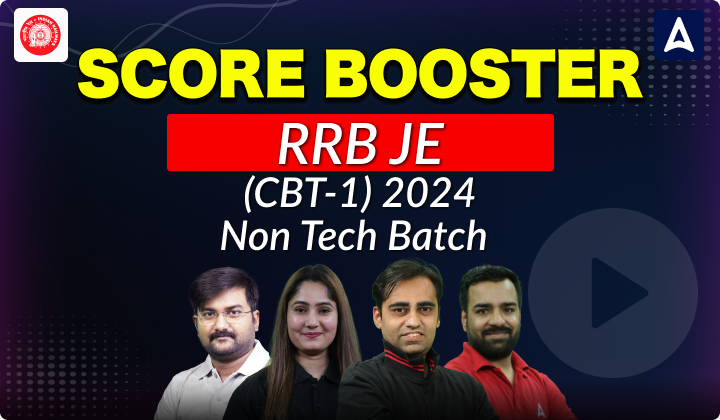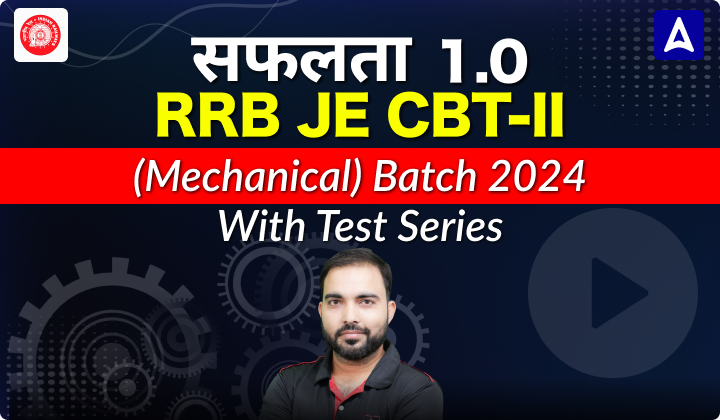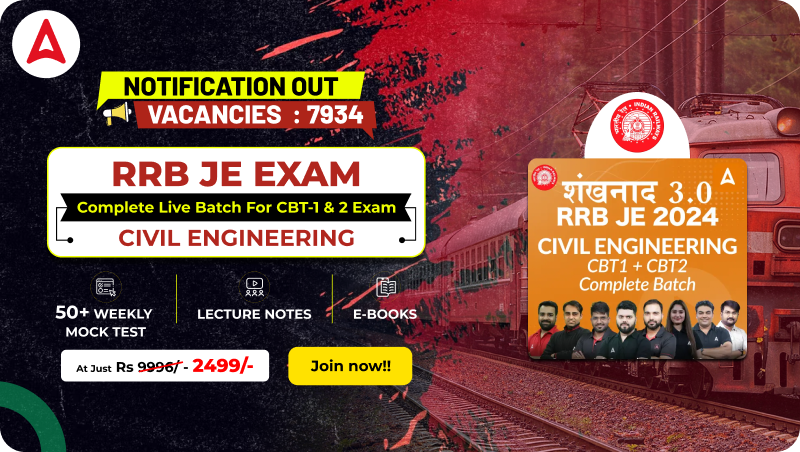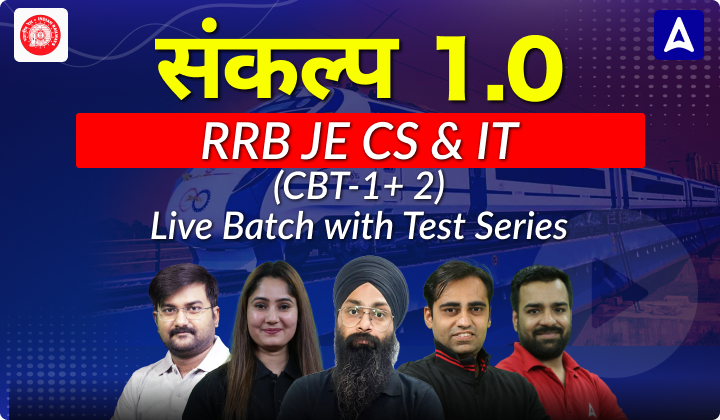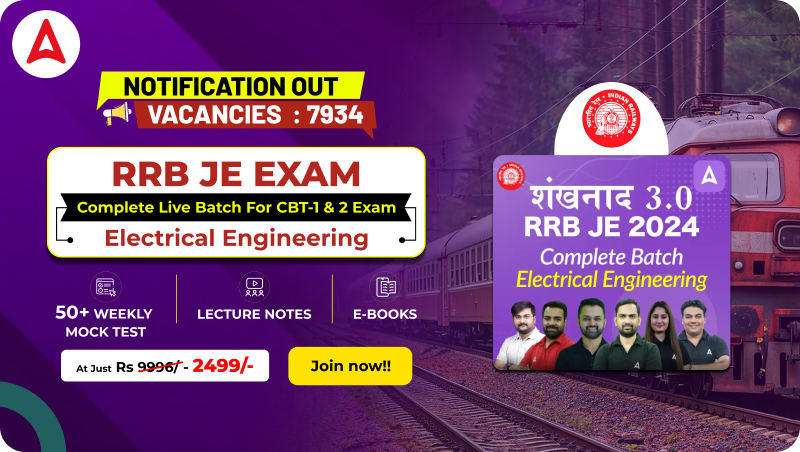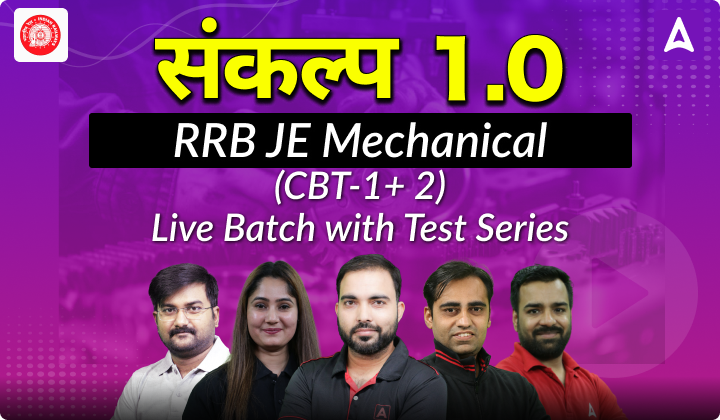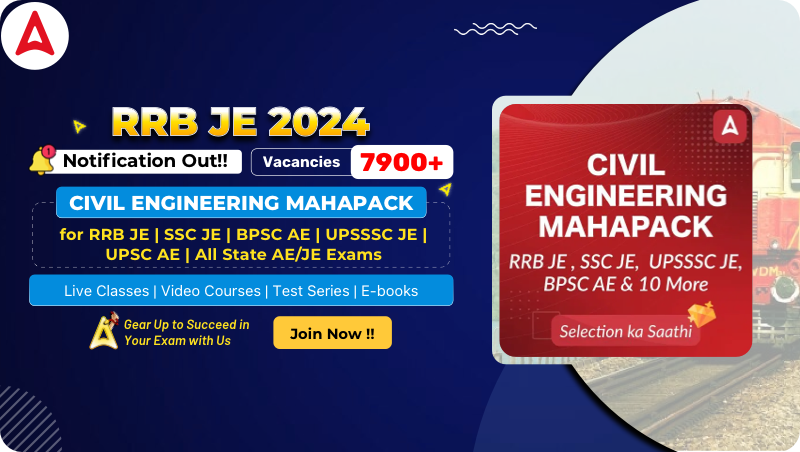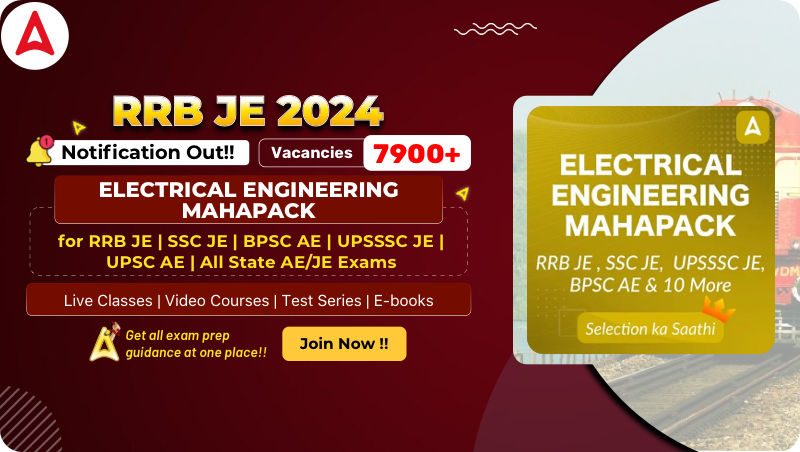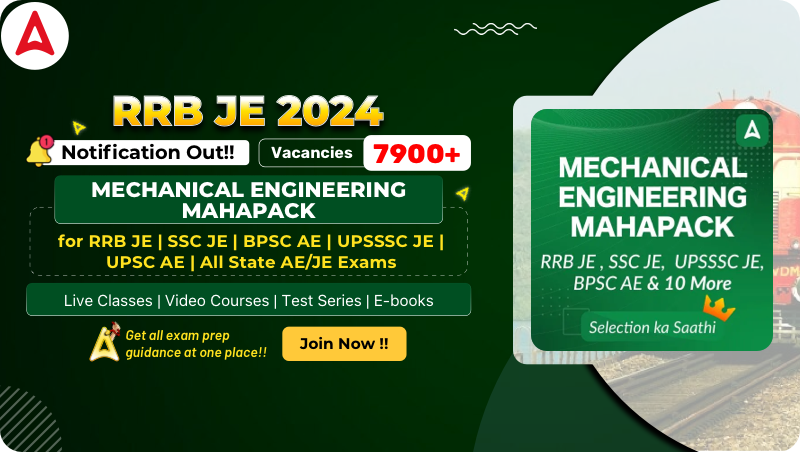Table of Contents
The Rajasthan Public Service Commission has published the RPSC AE Syllabus 2024 for the 1014 Assistant Engineer posts on the official website. Candidates can now begin their preparation using the RPSC AE Syllabus 2024 and Exam Pattern. This article provides all the details of the RPSC Syllabus 2024 for both the Prelims and Mains exams. It also includes the complete RPSC Exam Pattern 2024. The aspirants shall read the full article carefully & bookmark the website for further Engineering Job Updates.
RPSC AE Syllabus 2024
This article provides a detailed overview of the RPSC AE Syllabus 2024 including a breakdown of subjects and the exam pattern. The RPSC AE Recruitment 2024 has two stages of the selection process Prelims and Mains. Candidates can find the syllabus for both stages here. Understanding the RPSC Syllabus 2024 will help candidates organize their preparation effectively. To qualify for the RPSC RAS Exam 2024, candidates must pass both the Prelims and Mains. Those interested can apply and begin their preparation using the provided syllabus and exam pattern.
RPSC AE Syllabus 2024- Overview
Candidates should be aware of the RPSC AE Syllabus 2024, which is summarized in the overview table.
| RPSC AE Syllabus 2024 | |
| Organization | Rajasthan Public Service Commission |
| Post | Assistant Engineers |
| Vacancy | 1014 |
| RPSC AE Syllabus | Available Here |
| Educational Qualification | BE/B. Tech |
| Selection Process | Prelims Exam, Mains Exam & Interview |
| Official Website | rpsc.rajasthan.gov.in |
RPSC AE Exam Pattern 2024
The RPSC AE Exam 2024 will happen in two parts: the Prelims and the Mains. The Prelims is just for qualifying, meaning you need to pass it to move forward, but it doesn’t count toward your final score. The Mains is the stage where your performance will be evaluated and selected. If you pass the Mains, you will be invited for a personal interview. All the details about the RPSC AE Exam Pattern 2024, including information for both the Prelims and Mains, can be found in the table below.
| RPSC AEN Exam Pattern 2024 | ||
| Prelims Exam Pattern | ||
| Section | Marks | Time Duration |
| General knowledge & General Science including General knowledge of Rajasthan its Geography, Economy, and culture | 200 | 2 hr |
| Optional Subject: Civil/Mechanical/ Electrical/ Agricultural | 200 | 2 hr |
| Mains Exam Pattern | ||
| Paper I: Hindi | 100 | 3 hr |
| Paper II: Social Aspects of Engineering | 200 | 3 hr |
| Paper III Optional Subject: Civil/Mechanical/ Electrical/ Agricultural | 200 | 3 hr |
| Paper IVOptional Subject: Civil/Mechanical/ Electrical/ Agricultural | 200 | 3 hr |
RPSC AE Prelims Syllabus 2024
The RPSC AE Syllabus 2024 Prelims includes General knowledge & General Science including General knowledge of Rajasthan its Geography, Economy, culture, and Civil/Mechanical/ Electrical/ Agricultural. Candidates can get the topic-wise bifurcation of the RPSC AE Prelims Syllabus 2024 from the table given below.
Syllabus for Current Affairs
- Current events of State, National, and International importance. National & International agencies and their activities. Games & Sports at State, National and International levels.
Syllabus for History & Culture
- Land Marks in the political and cultural history of India. Major monuments and literary works. Renaissance, struggle for freedom and national integration.
- The medieval background.
- Socio-economic life and organization.
- Freedom movement and political awakening.
- Political integration.
- Dialects and Literature.
- Music, Dance & theatre.
- Religious beliefs, cults, saints, poets, Warrior-saints, Lok Devtas & Lok Deviyan.
- Handicrafts.
- Fairs and Festivals, Customs, Dresses, and Ornaments with special reference to Folk & tribal aspects thereof.
Syllabus for General Science
- General Science will cover General appreciation and understanding of Science including matters of everyday observations and experiences. Candidates are supposed to be familiar with matters such as electronics telecommunications, Satellites and elements of computers (both Hard & software), and research labs including CSIR-managed national labs and institutes. Environment & pollution etc.
Syllabus for Economic Developments to Rajasthan
- Food and Commercial Crops of Rajasthan, Agriculture-based Industries, Major Irrigation, and River Valley Projects, and Projects for the development of the desert and waste lands. Indira Gandhi Canal Project, growth and location of industries, Industrial raw materials. Mineral-based industries, Small scale and Cottage industries, export items Rajasthani handicrafts, Tribes, and their economy. Cooperative movement. Tourism Development in Rajasthan. Various five-year Plans: Objectives and progress. Major economic problems of Rajasthan and obstacles for economic development. The current budget of Rajasthan and Central Government. Economic Reforms in India and their impact. Commercial banks and other financial institutions in Rajasthan.
Syllabus for Geography and Natural Resources
- Broad – physical features of the world important places, rivers, mountains, continents, oceans.
- Ecology and wildlife of India.
- Rajasthan’s Physiography: Climate, vegetation and soil regions. Broad physical divisions of Rajasthan. Human resources: problems of population, unemployment, poverty, Drought, famine and desertification in Rajasthan. Natural resources of Rajasthan. Mines and Minerals, forests, Land water. Animals’ resources. Wild-life and conservation. Energy problems and conventional and non-conventional sources of Energy.
Syllabus for Civil Engineering
- Engineering Materials and Constriction Technology: Selection of site for the construction of various types of buildings: Planning and orientation of
buildings. Bonds in masonry. Damp proof course. Scaffolding, underpinning, and ranking. Floors. Staircases. Roofs. Doors and Windows. Requirements of fire protection. Ventilation and air conditioning and acoustics. Building and highway materials and their IS code provisions. Stones, Bricks, timber, Lime, Cement, Mortar, Plain and reinforced Cement Concrete, Bitumen, and Asphalt. - Surveying: Generally adopted Scales, Chain, and Compass surveying; Leveling; temporary and permanent adjustments of levels and Theodolite. Use of Theodolite, tacheometry, Trigonometrical and Triangulation survey. Traversing and Traverse Adjustment, Contours and contouring, Simple Circular Compound and Transition Curves and their setting out, Theory of erros and survey adjustment. Computations of areas and volumes.
- Soil/ Geotchnical Engineering: Classification of soil as per I.S. code, Field identification tests for soils; water content, specific gravity, voids ratio, porosity, degree saturation; unit weight, density index etc; and their inter – relationship, determinations of various properties of soils as noted above as well as grain size distribution, consistency limits etc. Soil permeability and its determination in the laboratory and field; Darcy’s law, Flow nets, its Characteristics and uses.
Compaction and consolidation of soil. Quality control, soil stabilization methods. Boussinesq’s methods. Newmark’s chart and its uses. Shear strength parameters and their determination Bearing capacity, local and general shear failures, design Criteria for shallow foundation, Plate load test and standerd penetration test. Earth pressures on retaining wall. Stability of simple slopes. Significant depth of exploration, design features of undisturbed sampler. - Structural Mechanics: Stress and strains, elastic constants, factor of safety, relation among elastic constants. Bending moment and shear force diagrams for cantilever, simply supported and overhanging, fixed and continuous beams subjected to static loads :- concentrated, uniformly distributed and uniformly
varying. Theory of simple bending. Shear Stress, Influence lines. Deflection of cantilever, simply supported fixed and continuous beams. Determinate and
Indeterminate structures and frames pin jointed, Plane and space frames. - Steel Structure: Design of ordinary and plate girder beams, roof trusses welded joints, axially and eccentrically loaded columns, Grillage, Gusseted and slab base foundations. Provisions of IS : 800 and 875. Economic span of bridges.
- Reinforced Concrete Structures: Provisions of latest IS : 456, design of beams singly and doubly reinforced, design of shear reinforcement. Design of slabs spanning in two directions and T-beam slabs. Design of column axially and uniaxially eccentrically loaded. Design of isolated and combined column footings : Design of simple RCC cantilever and counterfort retaining walls. Reinforcement in overhead and underground water tanks.
- Fluid Mechanics including Hydrology and Irrigation: Hydraulic pressure at a point and its measurement. total pressure and centre of pressure on plane and curved immensed surfaces, Buoyancy. conditions of equilibrium of floating bodies; fluid flow conditions, Bernoulli’s, Navier-Stokes, Reynold’s equations, flow through orifices venturimeter, notches and wires, flow through pipes and open channels, Gradually and rapidly varied flow, Dimensional analysis, Momentum and angular momentum principles as applied to fluid in a control volume, applications of jets, Viscous flow, concept of drag, flow through pipes.
Engineering hydrology; Hydrology of floods and drought reservoirs and dams; overflow structures, ground water hydrology. Irrigation: canals, Kennedy’s Lacey’s theories, Khosla’s theories for design of hydraulic structures. Ground water and well irrigation, water logging. - Public Health Engineering: Per capita requirement of water for urban and rural areas, Forecast of population. Sources. Water supply standards of purity of public water supplies with various methods of purification; House drainage system Distribution network with all the ancillaries: system of drainage. Layout of
sewerage systems. Primary, secondary treatments, trickling filters, lagoons and other treatment units and their design criteria. Flushing of sewers; sewage treatment; rural water supply and sanitation. - Highway and Bridges: Principles of highway planning; classification of road land width, building line, center line, formation width, terrain classification, pavement width, Camber, longitudinal gradient sight distance, horizontal curve, super elevation, vertical curve, lateral and vertical clearances. Flexible pavements. Sub-base, base course and shoulder stone / Kankar brick soling, WBM courses, shoulders. Granular sub-base, stabilized soil roads cement / lime stabilized sub base, sand bitumen base course, crushed cement concrete base/sub-base course. Prime and tack coats, surface dressing, open graded premix carpet, semi dense carpet, build-up spray grout base course, bituminous base binder course. Asphaltic concrete, seal coats, mixed seal surfacing. Penetration macadam base/binder course, full and semi groups. Traffic Engineering : traffic characteristics, road user characteristics, vehicular characteristics, volume, speed and delay studies origin and destination study, traffic flow characteristics, traffic capacity and parking studies, traffic regulation, traffic control devices, Intersection control. Alignment: traffic engineering, pavem design, paving materials and highway construction and maintenance of different types of roads. Need for highway drainage and arboriculture, types of bridges: choice of type of bridge, economical considerations of fixing spans culverts.
Syllabus for Electrical Engineering
- Electrical Circuits: Circuit components, KCL and KVL, network graphs, Methods of circuit analysis, Nodal and Mesh analysis, Analysis of D.C. and A.C. networks. Network theorems: Basic network theorems and applications. Network Functions: Driving point and transfer functions, poles and zeros of network functions. Response of networks to standard input signals. Two-port networks, Elementary network synthesis, different type of network parameters, signal flow graphs, Fourier series, Laplace transforms and their applications. Frequency response, Resonant circuits and applications. Threephase balanced and unbalanced networks. Steady state response with sinusoidal input. Transient response: Transient analysis of RL, RC and RLC circuits.
- Field Theory: Electrostatic and Magnetostatics : Electrostatics and electrical fields, Magnetostatics and magnetic fields, Field in conductors and in magnetic materials, field in dielectrics, Maxwell’s equations and time varying fields. Electromagnetic wave equations. Plane wave propagation in conducting and dielectric media.
- Electrical Materials: Classification of materials on the basis of permanent magnetic dipoles, Electrical and electronic behaviour of materials, classification on the basis of conductivity. Behaviour of dielectrics in static and alternating fields. Phenomenon of polarization. Super conductivity. Applications of magnetic, conducting, dielectric and insulating materials.
- Electrical Measurement and Instrumentation: General principles of measurement : Unit anddimensions. Standards error analysis, Basic methods of measurement, Measurement of circuit parameters by bridge methods. Measuring Instrument: Indicating Instruments, Integrating Instruments, Recording instruments. Measurement of voltage, current, power, power factor, energy, resistance, inductance, capacitance and frequency.
- Transducers : strain gauge, LVDT, resistance thermometers, thermisters, piezoelectric. Measurement of non-electrical quantities (Pressure, temperature, flow rate, displacement, velocity, acceleration, strain etc.)
- Digital measurements: Digital voltmeters, frequency counter, distortion meter. Telemetry and data transmission: Data recording and display, Data acquisition.
- Electronics and Communication: Solid state (semi conductor devices) : Diodes, Zener diodes. Transistors (Bipolar, BJT, JFET, MOSFET). Biasing and their applications. Analysis of electronic circuits, equivalent circuit. Rectifier, filter and voltage regulators. Single stage and multistage amplifiers-gain and frequency response. Multivibrators, flip-flops and their applications.
- Digital Electronics: Switching circuits and Boolean algebra and logic gates. Memories sample and hold circuits, A/D and D/A converters. Logic circuits including DTL, TTL, ECL, MOS, CMOS, digital IC’s (circuits). Communication: generation and detection of AM and FM noise behaviour of AM and FM systems.
- Microprocessor systems and computer: Microprocessor architectures, Instruction set and simple assembly language programming, interfacing memory and I/O devices. Applications of microprocessors. Basic layout of digital computers, input-output devices, memory organisations, algorithms, flowcharts.
- Power Electronics: Power semiconductor devices, Thyristor, triac, GTO, MOSFET. Static characteristics and triggering circuits. A.C. to D.C. Converters, choppers. Controlled and uncontrolled power rectifiers, Bridge converters.
- Control System: Open and closed loop systems. Block diagrams and signal flow graphs. Response analysis time domain, frequency domain; steady state error analysis. Root locus technique, bode plots, Routh-Hurwitz, and Nyquist criteria of stability. State space analysis of linear systems.
- Electrical Machines: Construction, Principles of operation, equivalent circuits, basic characteristics and applications of Distribution and Power transformers. Single phase induction motors. Threephase induction motors. Alternators, Synchronous motors.
- Power systems: Generation: thermal generation, Hydro generation, Nuclear Generation. Nonconventional energy sources. Transmission and Distribution. Transmission line parameters – resistance, Inductance and capacitance calculation, Performance of short, medium and long lines. Neutral earthing. Underground Cables. Corona, its effect and remedial measures. Basic idea of power system stability. Line insulators, introduction to HVDC transmission. Switchgear & protection: theories of arc extinction. Comparative merits of minimum oil, bulk oil, air blast, SF6 circuit breakers. Causes and consequences of dangerous currents. Currents limiting reactors. Busbar arrangements. Requirements of protective relays. Protection of lines, transformers, synchronous generators and busbars. Symmetrical components s and their applications
Syllabus for Mechanical Engineering
- Theory of Machines: Kinematic pairs, Kinematic chain, Mechanism and Inversion, Slider-crank chain, Displacement, velocity and acceleration of a point in mechanism and their determination, Coriolis acceleration, Mechanisms for straight line motion. Laws of friction, brakes and dynamometers, types of gears and gears trains. Types of Governors, Governor effort and power, static & dynamic balancing, Longitudinal, transverse and torsional vibration.
- Strength of Materials: Static stresses in machine parts, Deformation, Unit deformation (Strain), Poisson’s ratio, direct stress, shear stress, principal stresses. Compound stresses, torsional stress, stress – strain relationship, bending moment and shear force diagram for beams, Laminated and coil springs, shafts, thick & thin wall pressure vessels, Concept of fatigue, fracture & creep.
- Material Science: Crystal structure, space lattice, crystalline and amorphous solids, Coordination number, Atomic packing factor, determination of crystal structure, imperfection in crystals, mechanism of plastic deformation, work hardening, recrystalization, Heat treatment of steel, Composition, Properties and applications, Common engineering materials, corrosion, Plastics & their properties.
- Manufacturing Processes: Moulding and casting methods, Principle of arc and gas welding, Brazing & soldering, Metal forming processes, Basic machining processes and machine tools, Hot & cold working of metals, Mechanism of metal cutting, geometry of single point cutting tool and tool materials.
- Industrial Engineering and Management : Types of business organization, Principles of management, elements of management, organization charts, elements of costing, Break even analysis, types of budget and budgetary control, Profit & Loss account, balance sheet, motion study, time study, plant layout, material handling, CPM, PERT, Scheduling, dispatching, routing and inventory, Materials management.
- Thermodynamics: Basic concepts of thermodynamics, Laws of thermodynamics and their application to different flow and non-flow systems, Gas power cycles and vapour power cycles.
- Heat transfer : Conduction, convection and radiation phenomenon, Combined modes of heat transfer, Critical insulation, Fins, Non-dimensional numbers applied to heat transfer, Thermal boundary layer, Introduction to two phase heat transfer, Heat exchangers.
- Environmental Engineering : Basic air and refrigeration cycles, Vapour compression refrigeration, Vapour absorption refrigeration, Expansion devices, Refrigerants and their properties, Psychrometric chart and psychrometric processes, Air conditioning for human comfort and comfort chart, Cooling
load calculation. - Fluid Mechanics and trubomachines : Fluids and their properties, Kinematics and dynamics of fluid flow, dimensional analysis and similitude, Introduction to boundary layer flow, fluid flow through pipes, Flow measurements, Hydraulic pumps and turbines, Air compressors, Gas turbines and steam
turbines. - Power Generation : SI and CI engines, Combustion phenomenon, Fuels, carburetor and injection system, High pressure modern boilers, Stream plant layout and different accessories, Hydro power plant layout, Introduction to nuclear, MHD and biogas power plants, Economics and sharing of load techniques of different plants.
Syllabus for Agricultural Engineering
- Surveying, Leveling and Land Development: Linear Measurements, different surveying devices and methods, land grading and leveling, contouring and terracing, earth work estimation, land development budgeting.
- Soil and Water Conservation: Precipitation, hydrologic cycle, point rainfall analysis, frequency analysis. Watershed : definition and concept, agricultural watersheds, prediction of peak runoff, factors affecting runoff, hydrograph, concepts of unit and instantaneous hydrographs. Erosion-type and factors associated with erosion, assessment of actual annual soil loss by erosion and its impact on agricultural production and productivity. Erosion control measures on various classes of lands i.e. contour cultivation, strip cropping, terracing, afforestation, pastures etc. Role of vegetation in soil and water conservation, grassed water way and design. Design of gully control measures including permanent structures i.e. chute spillway, drop spillway, drop inlet spillway, retards and stream bank erosion mechanics of wind and water erosion, wind erosion control, water harvesting structures i.e.Khadin, Tanka, Nadi and Anicut.
- Irrigation: Soil-Water- Plant relationship, water requirements of different crops and irrigation scheduling, direct and indirect methods of soil moisture measurements, measurements of irrigation water. Water conveyance and control, design of field channels. Design of irrigation methods, irrigation efficiencies.
- Drainage : Benefits of drainage, Surface drainage, drainage of flat and slopping lands. Design and layout of surface and sub surface drains, depth and spacing of drains and drainage outlets, installation of drains and drainage wells. Pumps :- Construction and performance characteristics, selection, installation, working principle and maintenance of reciprocating pump, centrifugal pump, turbine pump, submersible Pump, propellers, jet and air lift pumps. Water Resources Development and Management: Water resources of India, surface water, ground water, development of irrigation potential, canal irrigation, command area development, on farm development works, aquifer parameters, hydraulics of wells, steady and unsteady flow, well log, construction of wells, well development.
- Farm Power and Machinery: Classification of Internal combustion (IC) engines terminology, Otto diesel cycle, engine components, Fuel supply system, Lubrication system, Cooling system and Governing system, steering system, hydraulic system. Types of tractors, brakes, power transmission system. Traction theory and mechanics of tractor chassis and selection of tractors.
- Farm Machinery : Tillage, primary and secondary tillage equipment, Selection of sowing and planting equipment and their calibration, Selection and calibration of sprayers and dusters. Principles, selection and operation of harvesting and threshing machinery. Cost analysis of farm equipment and related
numerical problems. - Agricultural Processing : Various size reduction machinery and material handling equipment. Separation equipment-based on size shape and surface characteristics. Heating and Cooling of food products, mode of heat transfer and types of heat exchangers. Psychometric chart and its application
in drying EMC and its determination, Principles of drying and drying equipments, types of evaporators, Refrigeration load calculation, various milling process for Rice, Maize, Wheat and Pulse milling, Parboiling of wheat and paddy. Grains storage structures and their design requirement. Principles of food preservation and thermal processing. - Farm electrification and rural hosing : Selection, Installation and general cares of electric motors on farms, selection of wire sizes based on Indian standards. Types of wiring, rural electrification programme. Rural Housing :- Building materials and their properties, Design of Beams, Slabs, Columns and foundations, Planning and design of rural houses, farm Roads, village drainage system, waste disposal and sanitary structures, material and cost estimation in construction.
- Renewable Energy : Solar Radiation – its measurement, solar thermal devices and gadgets i.e. solar cooper, solar water heater, solar dryer, solar refrigeration and air conditioner etc. Solar photovoltaic devices, Bio energy – production, conversion and utilization route, Biogas – type of biogas plant and
design of Biogas Plant. Biomass gasification and gasifier wind energy conversion process i.e., water pumping, wind mills and aero generator.
RPSC AE Mains Syllabus 2024
The RPSC AE Syllabus 2024 Mains includes four paper that deals with different topics. Candidates can get the topic-wise bifurcation of the RPSC AE Mains Syllabus 2024 from the table below.
Syllabus for Social Aspects of Engineering
- Development Processes: Inter relationship between social, economic, scientific and technological factors for development. Development criteria; gross national product, energy consumption.
- Rural economy, poverty, unemployment, exodus to urban areas. Land acquisition act.
- Globalisation of Economy: World Trade Organization (W.T.O.), trade related Intellectual Property Rights (TRIPS), Quality assurance, ISO certification. 5 ‘S’ Theory Optimisation of human, capital and material resources.
- Financing methods of infrastructure projects-BOT, PPP etc., Case studies of recent projects in Rajasthan-Refinery, IIIT, NHAI Highway, Dedicated Freight Corridor, Metro Rail Project.
- Technology for rural and Desert Areas, Characteristic of desert areas, Thar desert , desertification and its control, sand dunes stabilisation.
- Rural energy needs, Deforestation, Modern Solar appliances, Challenges in Solar Power and Wind Power Generation and their Connection to Grid.
- Rural industries. Soil and water conservation, water harvesting, watershed planning. Thermal comfort aspects of housing, transport in rural and desert areas, Drought, Famine and Disaster management.
- PMGSY Project. Right to Information act-its provisions.
- Technology Assessment and Transfer: Criteria for assessment and selection of technology, appropriate technology concept, technology transfer and development.
- Human Relations in Industry and Industrial Laws: Application of social sciences to industry, leadership and supervision, Labour relations, Trade unions, Salient features of Factory Act, Workmen’s Compensation Act, Minimum Wages Act. NAREGA project. Motivation. Conflict Management.
- Project Planning, Appraisal and Feasibility: Techno economic feasibility studies, Project planning and control, Use of CPM and PERT, Fixed and variable cost, IRR (Internal Role of Return), Cost-benefit ratio, NPV (Net Present Value) Break even analysis, Depreciation, life cycle costing. Software applications in life cycle cost analysis. Project Monitoring by SAP and other softwares.
- Environmental Degradation and Resource Depletion: Environmental degradation due to energy production, transport, industries, mining and intensive agricultural practices, control of air and water pollution. Hazards of environmental pollution. Health problems, challenges and their remedies due to sone industry, textile industry, coal based thermal power plants and refinery cum petrochemical complex in Rajasthan. Challenges and utilisation of industrial by
products (Like Flyash) in Rajasthan. - Depletion of natural resources due to population explosion and continuously rising standards of living. Environment impact analysis of projects, green technologies, Concept of sustainable development. National environmental laws. Carbon footprint of technologies, carbon credit system.
- Dumping of Radioactive waste-methods and monitoring. Effect on health.
- Development of Science and Technology: Information technology application in Project Designing, Project evaluation programme, implementation and monitoring
Syllabus for Civil Engineering- I
- STRENGTH OF MATEIALS: Behaviour of engineering materials in tension, compression and shear, elastic limit, yield stress, proof stress, nominal stress, actual stress and untimate stress, factor of safety, load factor and elastic constants. Principal stresses and strains, Strain energy, theories of elastic failure. Bending moment and shear force in statically determinate beams, stress due to bending moment and shear force, design of section, section modulus, elementary theory of torsion, combined bending and torsion. Forces in statically determinate plane trusses. Slope and deflection of statically determinate beams, deflection of statically determinate frames – Buckling of columns. Euler’s, Rankine’s and secant formulae. Combined, direct and bending stresses for short columns. Thin cylindrical and spherical shells.
- SOIL AND FOUNDATION ENGINEERING: Soil Exploration: Methods of site exploration, boring, sampling, standard penetration test. Preliminary definitions and relationship: Water content unit weight, specific gravity, void ratio, porosity and degree of saturation, density index, phase relationship. Index Properties: Specific gravity, particle size distribution, consistency of soils. Classifications of soils, field identification.
- Laboratory Test: Particle size analysis, liquid limit, plastic limit, proctor density, field density, permeability, shear box and unconfined.
- Soil water: Inter-granular and pore water pressure, Quick sand phenomenon, permeability, Flow not and its uses. Vertical pressure distribution: Boussinesg’s equations, Circular load, pressure bulb and its significance, Newmark’s chart. Contact pressure distribution.
- Consolidation: Concept of one-dimensional consolidation. Laboratory consolidation test, overconsolidated normally consolidated soils, settlement analysis.
- Shear Strength: Basic concept, Mohr-Coulomb Failure theory and measurement of shear strength.
- Earth Pressure: Lateral earth pressures (Active and Passive), Rankine’s and Coulomb’s theory.
- Stability of slopes: Methods of slices, friction circle method, Taylor’s method.
- Bearing Capacity: Definations, Terzaghi’s method, general shear and local shear failures, plate load
test. - Compaction: Field Compaction method, water content, field compaction control and factors affecting compaction. Pile Foundation: Types of piles, driving of piles, load carrying capacity of piles, pile load testing, under-reamed pile foundation, bored compaction piles. Well Foundations: Caissons, shapes of wells and component parts depth of well foundation and bearing capacity, forces acting on a well foundation. Well sinking.
- THEORY OF STRUCTURES: Statically Indeterminate Structures : Static and kinematics indeterminacy, Energy theorems, Stiffness and flexibility methods elementary analysis of structures, methods off consistent deformation, slope deflection and moment distribution. Analysis of beams (including continuous) and portal frames, Influence lines, Influence lines for moment, shear and reaction for statically determinate beams and planner trusses. Muller-Breslau Principle and influence lines for indeterminate beams. Rolling loads on beams- shear force and bending moment due to concentrated loads, uniformly distributed loads- shorter and longer than span.
- STRUCTURAL DESIGN-I: Loads: Specifications for loads on buildings and bridges. Reinforce cement concrete: Limit state theory, resistance to bending, shear and bond. Design of singly and doubly reinforced beams, one way, two way and flat slabs, columns with axial; and uniaxial moment loading, footing, cantilever and counterfort retaining walls, simple underground and elevated reservoirs, cantilever sheds, simple rectangular portal frames, spherical domes, staircase. Pre-stressed Concrete: Properties of high grade concrete and high tensile steel, pre-tensioning and post tensioning losses in pre-stress. Analysis and design of rectangular beams and slab.
- STRUCTURAL DESIGN-II: Steel Structures : Tension and compression members, single and built up sections, connection and splices, roof trusses, simple beams and Purlin connections, columns, lacing and batten, Grillage, Gusseted and slab base foundation. Plate and gantry girders, through and deck type plate grider bridges and with lateral bracings.
Syllabus for Civil Engineering- II
- FLUID MECHANICS: Fluid properties, types of flow, Fluid statics, forces on fully and partially submerged bodies, stability of floating bodies. Fluid kinematics, acceleration of fluid particle, velocity potential and stream function, irrotational flows, ideal fluid flow, Bernoulli’s, Navier Stokes, Reynold’s
equations, application. Flow measuring devices. Momentum and angular momentum principles as applied to fluid in a control volume, applications to jets. Introduction of viscous flow, concept of drag. Flow through pipes, Laminar and turbulent. Equations for boundary layer thickness and boundary shear over flat plates. Channel Flows (GVF and RVF), surges. Dimensional analysis and similitude techniques. - SURVEYING: Distance Measurements: Use of steel and metallic tapes, application of corrections, measurement of base line, errors in base line measurements, reduction to mean sea level, specifications for base line measurements, optical measurements of distances, use of substance bars.
- Angle Measurements: Principles of theodolite constrictions, temporary and permanent adjustment, precision in relation to nature of work, compass, varieties, limitations. Traverse adjustments. Verticle Measurements : Use of leveling instruments of level, level tubes, estimation of sensitivity, optics, care and maintenance, parameters to define quality of telescope, leveling instruments and theodolities, methods of records and reducing, stadia reductions, use of level rods, contouring, drainage and watershed lines. Methods of filling in details: Chain and compass, plane table and traverse surveys. Principles and adjustments of closed traverse, determination of missing data, solution of two point and three point problems.
- Other Surveys: Curve ranging using linear and angular measurements, simple compound and spiral curves. Measurements of area and volumes: Use of planimeter, measurements of areas and volumes including prismoidal, trapezoidal and Simpson’s method.
- CONSTRUCTION MATERIALS: (i) Building Materials : building stones, building bricks, steel (Plain, Tor, High-tensile and Structural), Timber, lime, cement, sand, surkhi, cinder, stone slabs and lintels, aggregates for cement concrete, paints, distempers, use of pozzolana manufacturing of lime concrete, cement concrete for plain, reinforced and pre-stressed concrete work.
(ii) Road Materials: Coarse aggregate, screenings and binding materials for WBM. Bricks for soling. coarse and fine aggregate for bituminous roads, IRC standard size aggregates, Tars and Asphalt. Asphaltic concrete, Asphaltic emulsions, Mastic Asphalt and Minerals fillers.
(iii) Constructions Stone Masonry: Ashlar, course rubble, random rubble, stone pillar, dry stone and arch masonry. - Bricks Masonry: Types and their uses hollow and reinforced brick work.
- Wood work: doors and windows.
- Steel works: Structural steel work, metal doors and windows.
- Roofing: Stone slab roofing, G.C. Steel sheet roofing, Asbestos cement sheet roofing, jack arch roofing, tile and thatch roofing.
- Flooring: Cement concrete flooring, flag stone flooring, terrazzo mosaic flooring, Terrazzo file flooring, Brick on edge flooring, timber Granolithic floor finish, linoleum and other floorings.
- Plastering: Lime plaster, cement sand plaster, composite, plaster, rough coat plaster, Araish plastering with Gypsum, Plaster of Paris, painting.
- Miscellaneous: Damp proof course, anti-termite treatment, sill, coping and corbelling. Centering and Shuttering: Centering form work, shuttering and moulds, timber trestles and false work, scaffolding and shoring, under pinning.
- Sanitary and Water Supply : Providing and laying galvanized iron PVC, asbestos cement, stone ware, cast iron and RCC pipes; sewerage and drainage system; over head and under ground tanks; manholes and gully chambers ; septic tank; soak pit, dispersion trench, floor and wall treatment in toilets, glazed tile work, downpour pipes.
- Construction Management: Management of construction, plants and equipments. Planning for construction using network analysis C.P.M. and PERT techniques. Shallow foundation: spread foundation, combined footing and strap footing, Mat or Raft Footing.
- HYDROLOGY AND WATER RESOURCES ENGINEERING: Engineering Hydrology: Hydrologic cycle, precipitation, evaporation, evapo-transpiration and infiltration. Estimation of dependable runoff factors effecting runoff. Rainfall runoff relationship, flood/drought estimation using frequency analysis and unit hydrograph methods. Groundwater hydrology, aquifers, steady flow towards fully penetrating wells confined and unconfined aquifers. Crop water requirements: consumptive use of water. Water depth and frequency of irrigation. Soil moisture and its variation in the root zone. Wilting point. Field capacity. Different methods of irrigation and irrigation efficiency. Duty, delta and outlet factor. Cropping patterns. Intensity of
irrigation, Command area development and its related problems. - Diversion Head Works: Principles of design of weirs on non-permeable and permeable foundations. Khosla’s theory, designs for uplift and exit gradient. Silt exclusion from canal head works.
- Canals: Lined and unlined canals. Lacey’s and Kennedy’s theories, Tractive force approach. Types of lining and its selection criteria. Lift Irrigation from Canals and Wells Ground water availability in unconfined aquifers. Safe yield formulae, construction and maintenance of wells. Relative merits of lift irrigation and flow irrigation.
- Storage Works: Different types of dams. Elementary concepts of masonry, concrete, earthen, butteress and arch dams. Forces gravity dams. Structural behaviour stability considerations and stress variation in gravity dams. Appurtenances, Foundation Treatment and control of seepage. Multi-purpose Project : Compatibility of Multi-purpose uses. Data needed in planning of multipurpose water resources projects. Reservoir planning, Environmental consequences of irrigation. Water logging, problems of alkalinity and salinity, Farm drainage and CAD works.
- TRANSPORT AND TRAFFIC ENGINEERING: Survey investigation and preparation of road project. Highway standard classification, land width, building line center line, formation width, terrain classification, pavement width Camber longitudinal gradients, sight distance horizontal curve, super elevation, vertical curve, lateral and vertical clearances. Design of Pavement: Flexible pavements.
- Pavement Construction: Sub-base, base course and shoulder stone/kankar brick soling, WBM courses, shoulders. Granular sub-base, stabilized soil roads, cement/lime stabilized sub-base, sand bitumen base course, crushed cement concrete base/sub-base course.
- Bituminous Course: Prime and tack coats, surface dressing, open graded premix carpet, semi dense carpet, built-up spray grout base course, bituminous base binder course. Asphaltic concrete seal coats, mixed seal surfacing. Penetration macadam base/binder course, full and semi grouts.
- Traffic Engineering : Traffic characteristics, road user characteristics, vehicular characteristics, volume, speed and delay studies origin and destination study, traffic flow characteristics, traffic capacity and parking studies, traffic regulation, traffic control devices, Intersection control. System approach in traffic management.
- Bridge Engineering: Components of bridges, classification of bridges, requirements of an ideal bridge, selection of bridge site, Bridge alignment, site investigation and collection of data, waterway of bridges. Economic span scour depth of foundation, Afflux, clearance, free board. Type of bridge superstructures and methods of erection, bridge bearings, joints in bridge, wearing coat, Railing, parapet and approach slab. Type of bridge foundation, bridge pier, adjustment and wing walls. Training work for bridges and protection works. Low cost bridges, causeway, timber bridges, suspension bridges, pipe and slab culverts.
- WATER SUPPLY AND SANITARY ENGINEERING: Water Supply Engineering: Quantitative requirements of water supply for urban and rural areas. Variation in demant. Forecast of population. Different sources of water supply, lakes, rivers and ground water. Intake arrangements. Drinking water standard for water. Bacteriological test. Pumping of raw water. Design of rising mains. Water treatment, flow diagram, sedimentation coagulation, filtration and disinfection, water softening and aeration of water. Water distribution system and their design and analysis. Clear water reservoirs. Rural water supply and sanitation. Problems of low cost potable water for rural population. Tube wells for water supply. Safe yield from tube wells.
- Sanitary Engineering: sewerage, separate sewers and combined sewers. Hydraulic and structural design considerations. Different types of pipe material and different shapes of build up sewers. Superimposed load n sewers. House plumbing, various accessories and arrangement. Sewage pumping station.
- Characterization of Sewage : Physical, chemical and biological analysis, Industrial waste water and its problems, natural purification process through soil mass and through water bodies self purification of streams. Sewage treatment, Physical treatment, screening, skimming tanks, Grit chamber, Settling tanks. Secondary (biological) treatment, trickling filters and high rate bio filters. Activated sludge and accelerated aeration plants. Secondary, settling tanks, sludge digesters and sludge drying. Final disposal, Low cost waste water treatment oxidation ponds, oxidation ditches, aerated lagoons, septic tank, anaerobic lagoons. Dry refuse disposal. Basic concepts of Urban and Rural sanitation.
Syllabus for Electrical Engineering- I
- Electrical Circuits: Circuit elements, Kirchhoff’s laws, Mesh and nodal analysis, topological concepts, Network Theorems and applications. Natural response and forced response. Steady state and transient response for standard inputs. Properties of network in terms of poles and zeros. Transfer functions. Resonant circuits. Three-phase balanced and unbalanced circuits. Two port networks. Signal flow graphs. Coupled circuits. Filters, image impedance, attenuation, phase shift and insertion losses in constant K and M derived filters. Fourier series, Laplace transforms and their application.
- Field Theory: Electric and magnetic fields, Gauss’s law, Ampere’s law, Divergence and curl. Fields in dielectrics, conductors and magnetic materials, Maxwell’s equations. Time varying fields. Wave propagation in dielectric and conducting media.
- Electrical Materials: Classification of materials on the basis of permanent magnetic dipoles. Electrical and electronic behaviour of materials. Classification on the basis of conductivity. Behaviour of dielectrics in steady and alternating fields. Phenomenon of polarization. Super conductivity. Application of magnetic, conducting, dielectric and insulating materials, Piezoelectricity.
- Electrical Machines: Construction of large power and distribution transformers, Phasor diagram and equivalent circuit of transformers. Regulation and testing of transformers, power loss calculations, efficiency and all day efficiency. Starting methods of single phase motors. Applications in domestic appliances. Principle of operation, constructional features and performance analysis of three-phase induction motors. Torque-slip characteristics, Circle diagram. Methods of starting and testing. Construction, circuit model, operating characteristic, performance analysis, synchronous reactance, efficiency, voltage regulation, parallel operation of an alternator. Starting of synchronous motor, V-curves, hunting and its prevention.
- Power systems: Type of power stations : hydro, thermal and nuclear stations. Pumped storage plants. Economics and Operating factors. Power transmission lines, modelling and performance characteristics, voltage control, optimal power system operation. Load frequency control, symmetrical short-circuit analysis. Symmetrical components, p.u. representation, fault analysis, transient and steady state stability of power systems. Equal area criterion. Corona, Neutral earthing. Power system transients, power system protection, circuit breakers, relays, H.V.D.C. transmission
Syllabus for Electrical Engineering- II
- Electrical Measurement and Instrumentation: Units and standards. Error analysis. Measurement of current, voltage, power factor and energy, Indicating instruments. Measurement of resistance, inductance, capacitance and frequency by bridge methods, electronic measuring instruments, digital voltmeter and frequency counter. Transducers and their applications for the measurement for non-electrical quantities like temperature, pressure, flow rate, displacement, velocity, acceleration. Telemetry and data transmission. Data acquisition systems. A/D and D/A converters.
- Electronics and Communication: Semiconductor devices physics. P-N junction and transistors, circuit models and parameters. FET, ZENER, TUNNEL, SCHOTKY, photodiodes and their applications, rectifier circuits, voltage regulation, switching behaviour of diodes and transistors, small signal amplifiers biasing circuits, frequency response, multistage amplifier and feedback amplifiers. D.C. amplifiers, oscillators.
- Large signal amplifiers: coupling methods, push-pull amplifiers, operational amplifier, wave shaping circuits,. Multivibrators, flip-flop and their applications. Digital logic gate families, universal gates, combinational circuit for arithmetic and logic operation, sequential logic circuits. Counters, registers,
RAM and ROMs. - Communication: Generation and detection of AM and FM, noise behaviour of AM and FM systems.
- Power Electronics : Power semiconductor devices. Thyristor, power transistor, GTOs and MOSFETs characteristic and operation A.C. to D.C. converters, single-phase and three-phase D.C. to D.C. choppers. Inverters, single-phase and three-phase pulse width modulation. Sinusoidal modulation. Switched mode power supplies.
- Microprocessor systems and computers: Microprocessor architecture, instruction set and simple assembly language programming. Interfacing memory and I/O devices. Applications of microprocessors. Basic layout of digital computers, input-output devices, memory organizations. Algorithms. Flow charts.
- Control System: Open and closed loop systems. Block diagrams and signal flow graphs, transfer function. Response analysis, time domain, frequency domain, steady-state error analysis. Root locus technique, Bode plot, Routh-Hurwitz and Nyquist Criteria of stability. State space analysis of linear
systems.
Syllabus for Mechanical Engineering- I
- Theory of Machines: Kinematics and dynamic analysis of mechanisms, Coirolis component of acceleration, Mechanisms for straight line, Motor vehicle steering mechanism, Hooke’s Joint and Geneva mechanism, Kinematics synthesis of mechanism, Velocity and acceleration analysis, Brakes and dynamometers, Cams, Governors, Gears and Gear trains, fly wheel and turning moment diagram, Friction (types), Laws of friction, Inclined plane, Ball & roller bearings, single and multiplate clutches, Force analysis of machines, Force and inertia torque analysis of mechanisms, Balancing of rotating and reciprocating masses, Balancing of single and multicylinder engines, Gyroscopic motion, vibration analysis of free, damped and forced vibration of single degree of freedom, Vibration isolation and transmissibility, Transverse vibration and whirling (critical) speed of shaft, torsional vibration up to three rotor system, geared system, Holzer’s method.
- Materials Science: Crystal structure, space lattice, crystal systems, Miller indices, Imperfection in crystal, determination of crystal structure, mechanism of plastic deformation, Theory of work hardening and recrystalization, concept of creep, fatigue and fracture, Phase diagrams, Heat treatment of steels, Plain carbon steel, alloy steels, effect of alloying elements in steel, Composition, application and properties of common engineering materials, Materials for Nuclear energy and bearing materials.
- Machine Design: Design procedure and flow diagram, Factor of safety, unit deformation (strain), Types of stresses, stress-strain relationship, Deflection in beams, bending moment & shear force diagram, Eccentric loading, theory of fatigue, Statistical nature of fatigue, Endurance limit and its modification factor, Concept of fracture in ductile and brittle metals, Creep behavior in metals, Design of levers, beams, shafts, laminated and helical springs, belt, pulleys and flywheel, power screw, gear drives and friction clutches, thin and thick wall pressure vessels.
- Manufacturing Processes: Types of patterns and pattern making, Moulding and casting methods, Principles of arc welding and equipment, oxy-acetylene gas welding, gas welding flames, Brazing and Soldering, hot and cold working of metals, Introduction to Lathe, Milling, shaper and drilling machine,
Cutting tools, Merchant’s force analysis, geometry of single point cutting tool, types of chips, Taylor’s tool life equation, Economics of metal cutting, Modem machining methods, NC & CNC, Jigs & fixtures, fits, tolerances and limits, measurements of screw threads and gear profile, gear manufacturing, Press tools and high velocity forming. - Industrial Engineering: Type of business, their formation and dissolution, Government control, public corporations and co-operative societies. Introduction to management, Principle of Management, elements of management, contribution of Taylor, Gilbreth, Fayol and Mayo in the development of management, Forms of organization, management structure, Authorities and responsibilities, organizational charts, span of control, Work study and productivity, motion study, time study, theory of work sampling, Make and buy decision, probability theory, Game theory, replacement theory, principle of plant layout, Material handling: functions, engineering & economic factors, production planning and control, routing, scheduling and dispatching, Gannt’s chart, CPM, PERT, Material Management, Planning and Programming, Inventories, lot size, lead time, re-order point, wages payment system, Introduction to linear programming, Value engineering, JIT and MRP, Labour legislation, Industrial Relations.
Syllabus for Mechanical Engineering- II
- THERMODYNAMICS: Basic concepts of thermodynamics, Properties of pure substances, First law of thermodynamics applied to closed and open systems, Second law of thermodynamics, Carnot cycle, entropy, Second law analysis of engineering systems, Availability.
- Gas Power Cycles: Air Standard Efficiency, Otto cycle, Diesel cycle, Brayton cycle with modifications, Ideal jet propulsion cycle.
- Vapour Power Cycles: Carnot and Rankine cycles, reheat and regenerative cycles, reheat factor, binary vapour cycle, combined gas-vapour power cycle.
- Combustion: Solid, liquid and gaseous fuels, stochiometric air and excess air, Gas analysis, Different calorific values, Enthalpy of reaction and enthalpy of formation, Dissociation.
- Conduction: One- dimensional steady state heat conduction, Heat conduction through composite walls, Critical thickness of insulation, Heat transfer from finned surfaces, fin efficiency and effectiveness.
- Convection: Free and forced convection, Dimensional analysis, Heat transfer correlations, Hydrodynamic and thermal boundary layers, boundary layer equations and their solutions for flat plates and pipes.
- Radiation: Planck’s distribution law, Radiation properties, Kirchoff’s law, diffuse radiation, Lambert’s law, Intensity of radiation, Heat exchange between two black surfaces, Heat exchange between gray surfaces, radiation shield, Electrical analogy,
- Boiling and Condensation: different regimes of boiling heat transfer, Correlations of boiling heat transfer, Heat transfer coefficient for laminar film condensation on flat plate, Drop wise condensation.
- Heat Exchangers: Different types of heat exchangers, Logarithmic mean temperature difference and effectiveness for parallel flow and counter flow heat exchangers, Correction factor and fouling factor, Heat exchanger design by LMTD and effectiveness NTU methods.
- Fluid Mechanics: Fluids and their properties, buoyancy and floatation, Kinematics and dynamics of fluid flow, similitude and dimensional analysis, Incompressible fluid flow in pipes, Steady flow of compressible fluids – normal shock waves, Fanno and Rayleigh lines, Oblique shock waves, Flow in a pipe with friction, Flow of viscous fluids – laminar and turbulent boundary layers, Fluid flow measurement.
- Fluid Machines: Centrifugal pumps: constructional details, specific speed, manometric and overall efficiencies, characteristic curves. Hydraulic turbines: classification constructional features of Pelton, Francis and Kaplan turbines, specific speed, velocity triangles, efficiencies, characteristic curves, governing systems, draft tubes, cavitation.
- Refrigeration : Basic refrigeration and heat pump cycles, Air refrigeration system, Aircraft refrigeration, Vapour compression refrigeration, Vapour absorption system, Refrigerants, Refrigerator components and controls, Unconventional methods of Refrigeration.
- Air-conditioning: Psychrometric charts, Different air-conditioning processes, Air-conditioning systems and equipments, air-conditioning plants, Selection of air-conditioner, Layout of different airconditioning systems, Air-distribution, duct design, Cooling Loads and their calculations, Human comfort and comfort chart, Different applications of refrigeration and air-conditioning.
- ENERGY CONVERSION : Combustion Internal Engines: S.I. and C.I. engines, Combustion phenomenon, Combustion chambers, carburetion and fuel injection, Supercharging, engine fuels, various efficiencies and performance of I.C. engines, Engines emission and control.
- Steam Turbines: Flow of steam through nozzles, Steam turbine types, Velocity diagrams for impulse and reaction turbines, Efficiencies and governing.
- Gas Turbines: Centrifugal and axial flow compressors, Energy transfer equation, Velocity diagrams, Efficiency and performance of gas turbines, Multistage compression, Reheat and regeneration.
- POWER PLANT ENGINEERING : Steam Power Plants: High pressure steam boilers and accessories, plant layout, Fuel handling and firing, ash, smoke and dust removal, Fluidized bed, Chimney and draught, Condensers, Heat balance sheet, Plant operation and maintenance, Thermal pollution and control. Hydro-electric power plants: Selection of site, Different layouts, Efficiency and load curves, Hydrology, hydrological cycle and hydrograph, Control in hydro-electric plants, Economic loading of hydro-power plants.
- Nuclear power plants: Nuclear reactions and fuels, Nuclear reactors, Nuclear power plant economics, Safety measures & site selection, Comparison of Nuclear, steam and hydro plants. Power plant economics: Economic load sharing between base load and peak load plants, typical load curves, Effect of variable load on power plant.
Syllabus for Agricultural Engineering- I
- Soil and Water Conservation: Forms of Precipitation, hydrologic cycle, point rainfall analysis, frequency analysis. Water shed – definition and concept, agricultural watersheds, prediction of peak runoff, factors affecting runoff. Hydrograph, concepts of unit and instantaneous hydrograph. Erosion-type, affecting factors, damages associated with erosion, assessment of actual annual soil loss by erosion and its impact on agricultural production and productivity. Erosion control measures on various classes of lands i.e. contour cultivation, strip cropping, terracing, afforestation, pastures etc. Role of vegetation in soil and water conservation, grassed water way and its design. Design of gully control measures including permanent structures i.e. chute spillway, drop spillway, drop inlet spillway, retards and stream bank erosion, flood routing, flood amelioration through soil and water management in upstream zone, mechanics of wind and water erosion, wind erosion control, water harvesting structures i.e. Khadin, Tanka, Nadi and Anicut.
- Irrigation: Soil-Water- Plant relationship, permeability, infiltration, percolation, water requirements of crops and irrigation scheduling, direct and indirect methods of soil moisture measurements. Measurements of irrigation water-Orifice, Weirs, Notches, Parshall flumes, H-flumes etc. Water conveyance and control, design of field channels and canals, Lacey and Kennedy theories, Most economical channel cross section. Underground pipe line structures and their design. Irrigation methods, their hydraulics and design viz – Border, Furrow, Flood, Drip and Sprinklers methods, concepts in irrigation efficiencies.
- Drainage: Benefits of drainage, hydraulic conductivity, drainable porosity, drainage Coefficient. Surface drainage, drainage of flat and sloppy lands. Design of open ditches, their alignment and construction. Design and layout of sub surface drains, depth and spacing of drains and drainage outlets, installation of drains and drainage wells, drainage of salt affected areas.
- Pumps: Design, construction, performance characteristics, selection, installation, working principle and maintenance of reciprocating pump, centrifugal pump, turbine pump, submersible Pump, jet pump, air lift pumps, and hydraulic ram.
- Water Resources Development and Management: Water resources of India, Surface water, Groundwater, development of irrigation potential, Canal irrigation, Command area development, On-farm development works, aquifer parameters, Hydraulics of wells, steady and unsteady flow, well log, construction of wells, Design of good screen, well development. Surveying, Leveling, and Land Development:- Linear Measurements, different surveying devices and methods, land grading and leveling, contouring, terracing, each work estimation, Land Development Budgeting, and earth moving machinery.
Syllabus for Agricultural Engineering- II
- Farm Power: Classification of Internal combustion (IC) engines terminology, Otto, Diesel cycle, basic IC engine components and functions, fuels and fuel supply system, lubrication system. Cooling system and governing system. Types of tractors, Transmission system – clutch, gearbox, brakes, PTO, differential. Mechanics of tractor chassis, principles of traction, steering system, hydraulic system, and selection of tractors.
- Farm Machinery: Farm mechanization, tillage, and tillage implements, types of hitching systems. Sowing and planting equipment and their calibration, Precision planting. Types of sprayers & dusters and their calibration. Selection and operation and principles of harvesting and threshing machines, reapers, combines, and threshers. Cost analysis of farm equipment and related numerical problems.
- Agricultural Processing: Various size reduction machinery and energy requirements. Material handling equipment. Separation equipment based on size shape and surface characteristics. Heating and Cooling of food products, mode of heat transfer, different types of heat exchangers. Psychometric chart and its application in drying EMC and its determination, Principles of drying and drying equipment, types of evaporators, single and multiple effect evaporators. Refrigeration load calculation, and various milling processes for Rice, Maize, Wheat, and Pulses. Parboiling of wheat and paddy. Storage structures for grains and their design. Principles of food preservation and thermal processing.
- Farm electrification and Machine: AC-DC Machines, DOL starter, Transformer, 3-phase Induction Motors and Alternators, Transmission and distribution of electricity. Selection, Installation & care of electric motors on farms. Selection and types of wiring based on Indian Standards and design of wiring systems. Rural electrification programmes.
- Rural Housing: Building materials and their properties, Design of beams, slabs, columns, and foundations, Planning and design of rural houses, farm Roads, Village drainage system, waste disposal, and sanitary structures, material and cost estimation in construction. Integrated rural energy planning and development.
- Renewable Energy: Solar Radiation – its measurement, solar thermal devices and gadgets i.e. solar cookers, solar water heaters, solar dryers, solar refrigeration, and air conditioning, etc. Solar photovoltaic devices i.e. solar lanterns, street lights, and power packs. Bioenergy conversion, production and utilization, Biogas – type, classification, and design of biogas plants. Biomass gasification and gasifier alcoholic fermentation (Ethanol and Methanol Production), wind energy conversion process i.e., water pumping, windmills, and aero generator.
RPSC Assistant Engineer Syllabus 2024 PDF
The detailed syllabus has not been published by RPSC yet for the Assistant Engineer (AE) posts but from the previous year’s papers, the subjects that have been covered for the RPSC AE Exam 2024 are given in this section. The aspirants are advised to download the RPSC Assistant Engineer Syllabus 2024 PDF for Prelims and Mains as given below and start their preparation.
RPSC AE Prelims Syllabus 2024- Click Here to Download PDF
RPSC AE Mains Syllabus 2024- Click Here to Download PDF




 DFCCIL Syllabus 2025 With New Exam Patte...
DFCCIL Syllabus 2025 With New Exam Patte...
 ONGC AEE Syllabus 2025, Check Exam Patt...
ONGC AEE Syllabus 2025, Check Exam Patt...
 WBPSC AE Syllabus 2025 and Exam Pattern,...
WBPSC AE Syllabus 2025 and Exam Pattern,...

